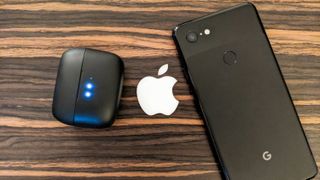Anker Soundcore Liberty Air review
The Anker Soundcore Liberty Air offers good comfort and sound at a budget price, but the connectivity and controls could be better
Why you can trust Tom's Guide

The Anker Soundcore Liberty Air shows the value of humble beginnings. From this dirt-cheap pair of AirPods clones, originally released in 2018, we now have one of the best-value ANC buds in the Anker Soundcore Liberty Air 2 Pro.
But the older pair of headphones isn’t just good for siring an older, more advanced pair. Even in more recent times it can be a viable low-cost alternative to the pricey Apple AirPods, and indeed, the white version currently sits high up our list of the best fake AirPods you can buy. To explain why, despite a few rough edges, our original Anker Soundcore Liberty Air review continues below.
- The best cheap wireless earbuds right now
- Get sporty with the best cheap running headphones
Anker Soundcore Liberty Air review: Price and availability
Most retailers sell the Anker Soundcore Liberty Air for around $60, though at the time of writing you can grab it for just $25 on Amazon.
The Soundcore Liberty Air is available in black or white, the latter clearly aping the AirPods. Anker is also more generous with accessories, bundling four sets of tips in different sizes and a micro-USB cable. Apple only provides a Lightning cable.
Anker Soundcore Liberty Air review: Design
I understand that Anker wants to achieve the same minimalist look as the AirPods. However, this is too on the nose of what Apple originally introduced, from the shape to the high-gloss finish, which attracts fingerprints and scratches easily.
That same banality carries over into the product’s build quality. Each earbud is covered in a soft-plastic shell that is slightly sturdier than the casing on the AirPods, but not enough to protect them from severe damage. Both models will break if you step on them. The only redeeming quality is the IPX5-rated coating that makes the earbuds sweat and water resistant.
The charging case is solid and has magnets on the inside to keep the buds locked in and protected; the look is similar to the AirPods' case, only longer and thicker. The lid opens easily to access or store the buds. Three LED lights on the front indicate the number of charging cycles; the bottom houses a micro-USB port.
Anker Soundcore Liberty Air review: Comfort and fit

Anker is known for creating light, comfortable earbuds. The Liberty Air follows this tradition — you can wear these for several hours on end and not worry about fatigue. The earbuds provide great stability and rest gently on the concha. The ear tips feel soft and fit securely as well.
No individual weight has been listed for the Liberty Air, but Anker lists the product at 2.1 ounces, which places it in a higher weight class than the AirPods (1.3 ounces). Apple’s charging case is more travel friendly, thanks to a slimmer profile and smaller design, but carrying the Liberty Air around as a complete package won’t weigh down your pockets or gym bag.
Anker Soundcore Liberty Air review: Controls and setup
The Liberty Air features touch controls and has more programmed gestures than the AirPods do; however, it’s just not as responsive as Apple’s buds.
When looking over the command list, it’s clear the Liberty Air was designed more as a calling headset than as wireless earbuds. Call management is controlled entirely on the right earbud. You can answer/end a call (1x tap), place a call on hold (2x taps), or reject/switch/transfer calls (tap and hold for 2 seconds). Music is controlled on both earbuds; the right is used for play/pause (1x tap) and skipping a track (tap and hold for 2 seconds), and the left for playing a previous track (tap and hold for 2 seconds). There are no volume controls, which meant I still had to pull out my smartphone to control the volume.
The controls take some getting used to, but getting them to work is even more of a task. Some truly wireless earbuds are super-sensitive to touch and often mistake the controls, but these buds just fail to register gestures — I had to perform them several times for the buds to recognize any activity.
Taking the Soundcore Liberty Air out of the charging case instantly places them in Pairing Mode, but the device struggled to communicate with compatible devices. When it worked, the process was standard: Enter your device’s Bluetooth settings, find “SoundCore Liberty Air” on the available list, and select it.
Anker Soundcore Liberty Air review: Audio quality

The Liberty Air won’t wow you with detailed sound like the Master & Dynamic MW07. What it does is reproduce music and low-frequency sounds clearer than the AirPods.
As I listened to Q-Tip’s “Vivrant Thing,” the bass levels were more accentuated than on the AirPods, which provided a stronger kick and reverberation. My head was nodding in sync with the record’s infectious bassline. Percussion sounded sharp and impactful, never once compromising the rapper’s airy vocals. Even when raising the volume to its highest level, the soundscape was balanced and distortion-free.
When switching to Prince’s 'Raspberry Beret," the buds showcased their mid-range exceptionally well. The Love Symbol himself commanded the soundstage over the densely layered beat, even giving the background singers some shine. But much like the AirPods, highs aren’t the Liberty Air’s specialty, so certain instruments, like the finger cymbals and violin, went unheard, not uncommon with many instrumental-heavy records.
I tested the buds with video content as well, and was met with mixed results. There was some latency when watching YouTube clips. To gain a better sense of depth, I pulled up the trailer for Jordan Peele’s "Us," and noticed recessed vocals. On the plus side, the buds gave the symphony-esque score of the Luniz’s “I Got 5 on It” some oomph and increased the fright factor.
Anker’s sound profile could benefit from some tweaking, which is a feature available on some wireless earbuds via companion app. Neither Anker nor Apple offer an app for their respective devices.
After securing a tight seal, the Liberty Air did a nice job of blocking out ambient noise. I was listening to music in my living room, with the TV at a high volume, and wasn’t interrupted by the intense debates on ESPN’s "First Take." Muting my cat’s attention-seeking cries was a blessing; the buds are also effective at silencing street sounds, such as rowdy pedestrians and truck engines; just don’t expect them to tune out horns or sirens.
Anker Soundcore Liberty Air review: Digital assistant support

It’s a swing and a miss for Anker when it comes to digital assistants. The Liberty Air supports both Siri and Google Assistant, but between the buds’ poor touch response and speech recognition, they go to waste here. Enabling the feature is frustrating, especially when listening to music at the same time. The buds couldn’t distinguish whether I wanted to pause music or pull up Google Assistant.
I had to perform the double-tap gesture a few times to activate the AI software; when I did, my voice commands were poorly translated. Using the feature outside was even more disastrous since the loud traffic noises drowned out my voice.
Anker Soundcore Liberty Air review: Battery life

Anker bills the Liberty Air at 5 hours on a full charge; realistically, it’s about 4 to 4.5 hours depending on usage, as phone calls and volume levels affect overall battery life. The battery life is about the same as the AirPods 4.5 hours, and longer than most models in its price class. I used the buds for 1.5 hours daily, which was enough for three days of listening before recharging. There’s also a standby mode programmed to automatically turn off the buds when not in use.
The charging case holds three charging cycles, providing 15 hours of additional playtime. It’s a good amount to work with, although it doesn’t match the AirPods case (24 hours). But make sure that the case has a decent amount of power; it won’t charge the buds at the same time it’s charging. After fully charging the case, the buds were at the same battery level (40%) as they were when I first took them out of the box.
Anker Soundcore Liberty Air review: Call quality and connectivity

As a calling headset, the Liberty Air is serviceable. Calls sounded low, but people could hear me clearly and I could make out what they were saying. I recommend using the buds indoors because the mics are sensitive to background noise, so you won’t be able to hear much in noisy settings. Most buds in the category only take calls in mono, but the Liberty Air lets you hear calls on both the left and right channels, like the AirPods do.
Most Anker audio products support Bluetooth 5.0, including the Liberty Air; unfortunately, the buds suffer from connectivity issues. It takes longer to reconnect to a device (estimated 1 minute) and dropout happens often on the left bud. The W1 chip in the AirPods makes pairing and switching between devices a breeze, and bud-to-bud connection is perfect.
When it did hold a connection, I was able to stream music within a 40-foot range. Another perk of having Bluetooth 5.0 is the option to connect to multiple devices simultaneously. The feature runs well, and I enjoyed the freedom of managing playback from my MacBook control panel while streaming Spotify on my smartphone.
Anker Soundcore Liberty Air review: Verdict
For such little cash, you should not overlook the Anker SoundCore Liberty Air as a potential AirPods alternative. These earbuds provide more comfort, better noise isolation and even better sound than its competitor, at half the price. But that doesn’t make the Liberty Air superior to the AirPods.
In fact, there are other truly wireless models that also cost even less than $100 while rising above the Liberty Air – the JLab JBuds Air come to mind. Nonetheless, if you’re an Anker fan who wants something more versatile than the AirPods and at a lower cost, you could do a lot worse than this pair of buds.
Sign up to get the BEST of Tom’s Guide direct to your inbox.
Upgrade your life with a daily dose of the biggest tech news, lifestyle hacks and our curated analysis. Be the first to know about cutting-edge gadgets and the hottest deals.
A lifestyle journalist with an affinity for consumer products, Alex has over a decade of experience and has worked with popular publications such as Complex, Thrillist, Men’s Health, Gear Patrol, AskMen, and Hoop Magazine. He currently focuses on audio, reviewing the most coveted headphones in the market for both Tom’s Guide and Laptop Magazine.

